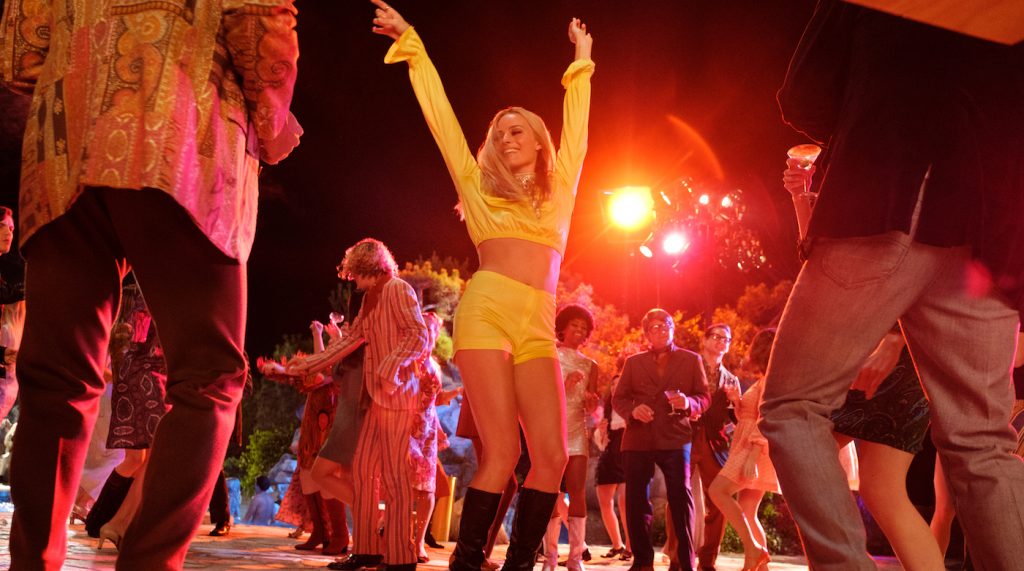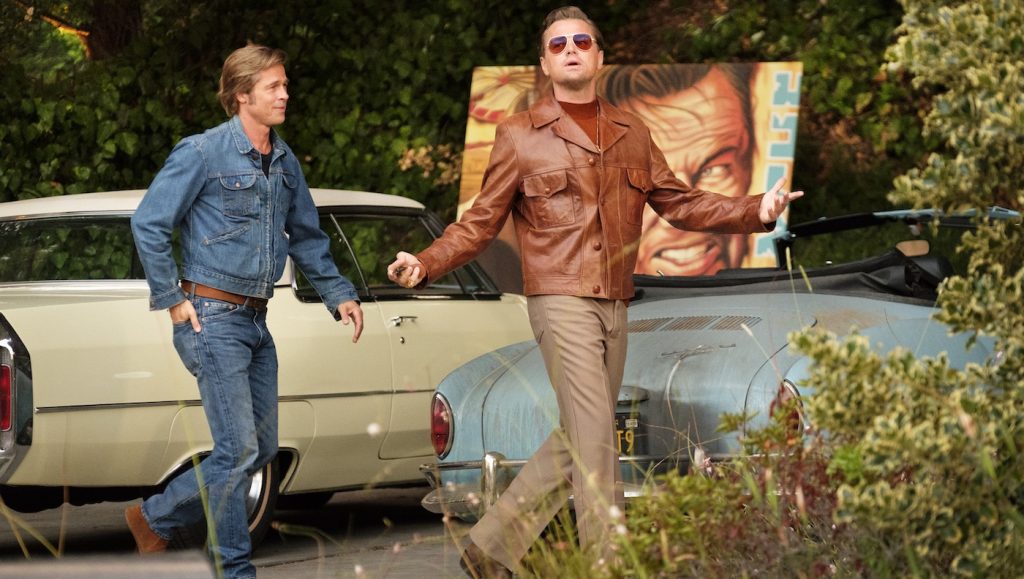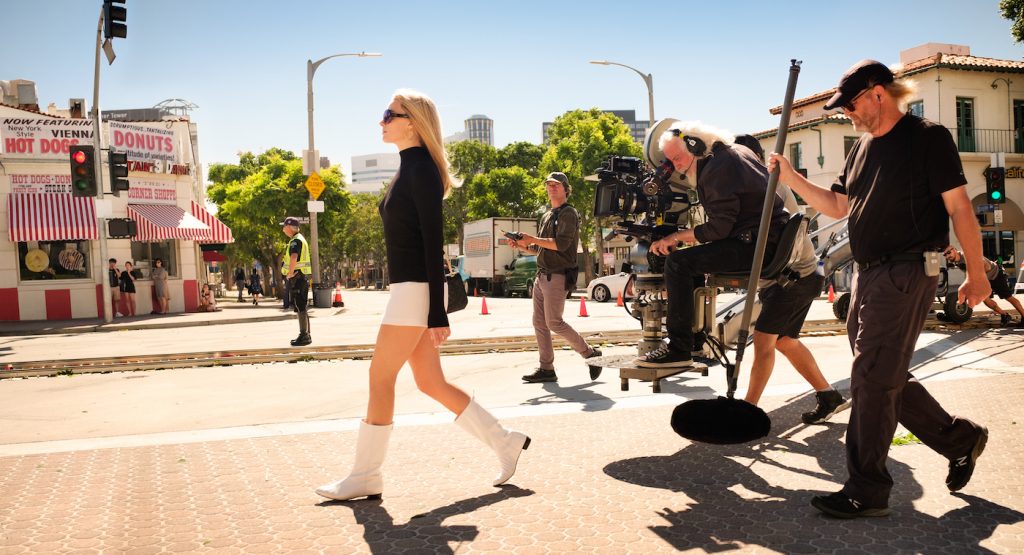Let’s Discuss Once Upon a Time in Hollywood‘s Ending
At long last, Once Upon a Time in Hollywood, Quentin Tarantino‘s 9th film, bowed this past weekend. Everyone knew that Tarantino’s star-studded ensemble film would deal, in some way, shape and form, with the gruesome murder of an 8-and-a-half-months-pregnant Sharon Tate (played by Margot Robbie) and four friends at the Hollywood Hills home she shared with director Roman Polanski. That night, August 9th, 1969, became one of the most infamous in American history. When word spread that Tarantino’s new film would deal, at least in part, with Charlie Manson’s lunatic acolytes butchering Tate and her friends, everyone wondered how in the world he was going to handle it. Here, of course, is where all of you folks who haven’t seen the film should stop reading.

Truly, no one wants or needs to see the Tate murders restaged, yet there was a real fear that Tarantino might do just that. Instead, the legendarily risk-happy auteur decided to handle this horrific piece of 20th-century history by using one of his favorite narrative methods—he rewrote the past. He saved Tate and her friends, but what’s more, he made the three Manson Family dopes who were planning on butchering her into literal punching bags—also chew toys. Then, for good measure, he set one of them on fire. With a flamethrower.
Tarantino has rejiggered history to suit his narrative—and one could argue emotional—needs a few times now. He’s given characters wronged by history—most memorably Méleanie Laurent’s French Jewish girl Shosanna in Inglourious Basterds (2009), and Jamie Foxx’s former slave Django in Django Unchained (2012)—the opportunity to seek revenge on their tormentors. Shosanna helps trap a theater-full of Nazis, including Hitler and Goebbels, in a successful plot to kill the lot of them in one fell swoop. Talk about catharsis. A few years later in Django Unchained, Foxx’s slave-turned-bounty hunter exacts revenge on an entire estate’s worth of sociopaths and torturers, freeing his wife in the process.
Now in Once Upon a Time in Hollywood, Brad Pitt’s Cliff Booth and his pitbull become Sharon Tate’s unwitting saviors. Flinching during one of Tarantino’s famously, often cartoonishly violent set-pieces is par for the course; doing so while watching Nazis, slave owners, and Manson Family members get their comeuppance layers in some confusing, conflicting emotions. You’re happy, but you’re also a little sad (that monsters exist, etc). You’re energized, but possibly a little sapped by the extremity of it all (Tarantino’s villains are rarely dispatched quickly—they need to feel pain and terror). The incalculably cruel Tex (Austin Butler), who butchered Sharon Tate in real life, is getting ripped apart here by a dog. Yay? Well yes, yay indeed. Booth’s dispatching of one of the female Manson Family would-be killers is a lot harder to cheer. That’s because it’s a lot, period. Yes, she was going to murder a bunch of innocent people, but it’s still hard to feel queasy watching Booth smash her face into various walls around the house. Although I was relieved that Tate was going to be spared, the dispatching of the Manson Family members was not easy watching. Perhaps the oddest and most wonderful thing about Once Upon a Time in America is how, when you strip away that extremely violent climax, the film is surprisingly, even touchingly sweet.

Rick Dalton (Leonardo DiCaprio) and his longtime stunt double and friend Cliff Booth (Pitt) are rendered as actual friends, not just Hollywood-types whose superficial friendship is based on using each other to get what they want or need. As Dalton’s career fades, his next-door neighbor, Tate, is becoming a star. What’s more, she’s married to Polanski, who at the time was one of the world’s most admired directors (and not the accused rapist who can no longer step foot in America). Tarantino’s story is mostly interested in the relationship between Dalton and Booth, yet Robbie’s performance is very winning as the young, rising star who seems genuinely stunned by her career. You know, or think you do, what’s coming. You desperately wish she could avoid her fate. Tarantino’s script and Robbie’s performance reconfirm Tate’s humanity and her history as much more than just the most famous victim of the most famous killer in American history.
While you watch Once Upon a Time in Hollywood with a sense of increasing unease at the approach of the night of August 9th, you might also notice something that felt, at least for me, somewhat unusual in a Tarantino film—a mellowness, and compassion for these three characters. Which, of course, increases the dread of the murder you still think is coming.

Dalton is a fading star, and Booth has some disturbing domestic history, and Tate’s milieu—the fancy, famous friends, the parties at the Playboy Mansion—could all have been played for laughs. The story could have depicted Dalton has another self-obsessed actor raging at the dying of the light of his once-promising career. Booth could have been a braindead beefcake with a shady past, nothing more. Although it would have been unwise, Tate could have been simply the film’s sacrificial lamb, the pretty, promising actress whose life, and the life of her unborn child, were cut short in the most infamous murder in American history. Tarantino wasn’t having any of it. Dalton and Booth’s friendship is real, and each man is fully dimensional, as well as creatures of a very specific Hollywood of 1969. And Robbie’s Tate is depicted as warm, lovely, full of life. A life that meant more than just the way it ended.
A friend of mine wrote of Tarantino’s revisionist ending that it made her think of “the randomness of time and consequence.” I liked this take. What Tarantino posits here is an alternate history that actually could have been, rather than the fantastical, Hitler-vanquishing catharsis that was Inglourious Basterds famous theater massacre scene. Tarantino maps out the fateful night—with help from both onscreen text and Kurt Russell’s narration—and shows just how many things could have happened differently to change the course of this particularly grim history. Sharon Tate and her friends have dinner at Tate’s favorite restaurant, the El Coyote Cafe, while Dalton and Booth get fantastically drunk at another Mexican restaurant in the Valley. When the Manson family comes driving their muffler-less car up Tate and Dalton’s street, Dalton’s drunk enough to make a major issue of something he might have let go otherwise. Any number of small little disturbances in the timeline of that night could have changed the fate of the five people who were murdered. Tarantino has created a movie around that notion, and then given us, once again, a stylized, very violent alternate history in which the bad guys don’t just lose, they get routed.
The climactic scene is pure Tarantino. The three Manson family would-be murderers burst into Dalton’s house, where Booth—stuntman, war veteran—is tripping on acid and hanging out with his pit bull. The Manson Family summons Dalton’s new wife from her bedroom (Dalton himself is drinking frozen margaritas in his pool, listening to his portable tape deck, oblivious), with their ostensible leader, Tex, making a big to-do about how they’re the devil’s hand, or something, telegraphing that the plan is to murder everyone in the house. Not tonight. Instead, Booth clicks his tongue and his dog launches into action, one head of Tarantino’s three-headed avenging angel (the others belong to Booth and Dalton) who will exact revenge on Sharon Tate’s killers before they ever get a chance to make their awful history. Tarantino gets in a few callbacks to previous scenes and his previous films, with the entire, insane melee ending with Dalton retrieving the aforementioned flamethrower (from a previous film-within-the-film) and torching one of the would-be killers, much like Shoshanna’s Nazi victims were torched in the theater.
And this, in Tarantino-land, counts as a happy ending. In fact, when Dalton ends up getting invited over to Tate’s that very night for cocktails and to talk about the three crazy hippies who just broke into his home, fulfilling his hope of meeting Tate and, possibly, getting a gig in a Polanski film, you could be excused for having all sorts of conflicting feelings. The most potent emotion of all, for me at least, was relief.
For more on Once Upon a Time in Hollywood, read our interview with cinematographer Robert Richardson here.
Featured image: Margot Robbie stars in ONCE UPON TIME IN HOLLYWOOD. Photo Credit: Andrew Cooper



